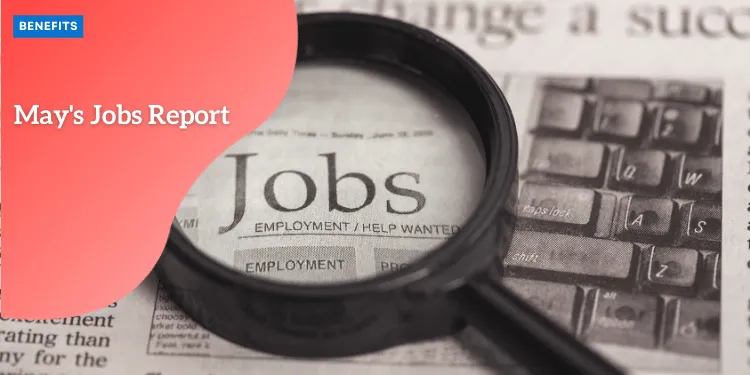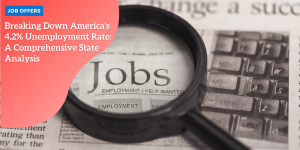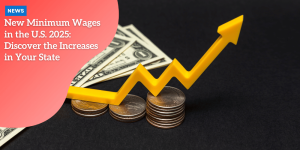May’s Jobs Report

In May, the US economy witnessed a significant surge in hiring, with employers adding a robust 272,000 jobs.
Anúncios
Despite facing persistent challenges such as inflation and high interest rates, this growth signals a positive trajectory for the economy’s recovery.
However, the unemployment rate saw a slight increase from 3.9% to 4%, marking its highest level since January 2022.
Wage Growth and Inflation
Average hourly pay rose by 14 cents to $34.91, resulting in a yearly increase of 4.1%.
Anúncios
While wage growth has decelerated compared to the peak of the pandemic, it still exceeds the Federal Reserve’s target of 2% inflation.
Many Americans have experienced pay raises that outpace inflation, thereby enhancing their purchasing power.
Federal Reserve’s Response
The Federal Reserve is closely monitoring the employment data, particularly regarding wage growth and its impact on inflation.
Anúncios
Economists predict that the report may not prompt immediate action from the Fed to lower interest rates, as wage growth continues to be a concern.
Fed officials have emphasized the importance of achieving sustainable progress towards the inflation target before considering any adjustments to monetary policy.
Interest Rate Outlook
Since March 2022, the Fed has raised its key short-term interest rate to combat inflation.
However, market expectations regarding future rate cuts have shifted, with predictions now suggesting one or two cuts, potentially starting in September.
The central bank may delay further rate adjustments until next year if inflation remains elevated.
Leading Industries in Hiring
Key sectors driving job growth include healthcare and social assistance, leisure and hospitality, and professional and business services.
Additionally, the public sector witnessed significant gains, contributing to the overall increase in payroll numbers.
Factors Influencing Job Growth
Several factors influenced May’s payroll totals, including weather conditions, calendar quirks, and ongoing labor market dynamics.
While heavy rains may have affected hiring in April, improved weather conditions likely provided a boost to job numbers in May.
However, challenges such as labor shortages and fluctuations in the supply of workers continue to impact hiring trends.
Inflation Goal and Interest Rate Policy
Some experts advocate for revisiting the Fed’s 2% inflation target and adjusting interest rates accordingly.
While immigration and the influx of students during the summer months may contribute to the labor force, uncertainties remain regarding their timing and impact on job availability.
Assessment of the Job Market
Overall, the job market has displayed resilience despite prevailing economic conditions.
However, there are indications of a gradual cooling, with job gains slowing in April and job openings declining.
While businesses have been cautious in their hiring practices, the pace of employment growth is expected to moderate in the coming months.
Challenges and Opportunities Ahead
Looking ahead, policymakers and economists face a range of challenges and opportunities in sustaining economic growth.
Addressing issues such as inflationary pressures, labor market dynamics, and interest rate policies will be critical in shaping the trajectory of the economy.
Additionally, efforts to enhance workforce participation, promote job creation, and support small businesses will play a pivotal role in driving recovery efforts.
Policy Implications
Policymakers must remain vigilant in their efforts to support the economy while also mitigating risks and uncertainties.
This includes implementing targeted fiscal and monetary measures to address immediate challenges and foster long-term growth.
Moreover, fostering collaboration and coordination among stakeholders will be essential in formulating effective strategies to navigate the evolving economic landscape.
Additional Analysis and Insights
Expanding on the discussion, it’s essential to delve deeper into specific aspects of the employment report and their implications for various stakeholders.
This includes examining regional disparities in job growth, analyzing demographic trends in workforce participation, and assessing the impact of technological advancements on job creation.
Furthermore, exploring the role of government policies in shaping employment outcomes and promoting inclusive growth can provide valuable insights into addressing systemic challenges and fostering an equitable recovery.
Future Outlook and Strategic Considerations
Looking to the future, it’s crucial to anticipate emerging trends and developments that could shape the economic landscape in the months and years ahead.
This includes preparing for potential disruptions such as geopolitical tensions, natural disasters, and global health crises, while also capitalizing on opportunities for innovation, entrepreneurship, and sustainable development.
Moreover, fostering a resilient and adaptable workforce will be essential in navigating uncertainties and driving progress towards shared prosperity and well-being for all.





